August: Who doesn't love a field trip?
Frontenac State Park Association newsletter
August 2024 (Vol. 2, No. 8)
Questions, comments, compliments, complaints, contributions? Newsletter editor Pamela Miller can be reached at pamelamarianmiller@gmail.com.
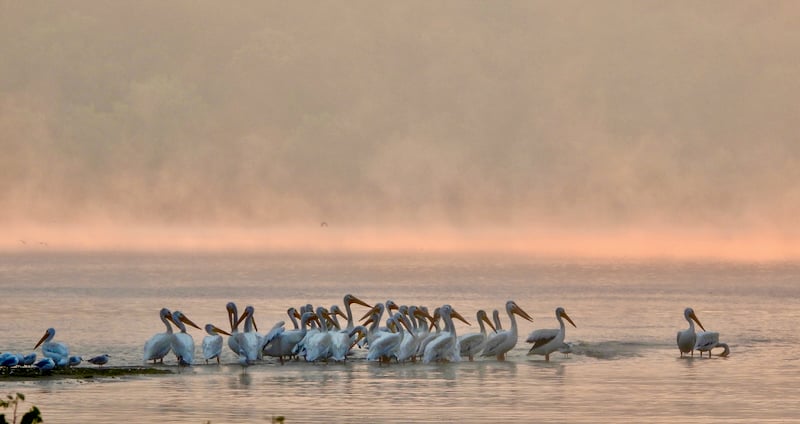
August: Who doesn’t love a field trip?
August! Languid, mature summer is at hand, featuring bright, breezy, steamy days and nights in which tree frogs and crickets sing you to sleep. In Frontenac State Park, native grasses and wildflowers sway in the warm wind, sheltering deer, birds and all manner of creatures that burst out to surprise and delight you as you amble along the trails. What a great time of year!
The heavy rains and flooding that have marked our summer so far have ebbed, but the Sand Point Trail is still a muddy mess. Barring further “rain bombs,” it should dry up and allow access to the Lake Pepin beach once again. Expect it to be, well, a little messy. And rest assured that your Frontenac State Park Association friends will clean it up. But, yeah, give us a little time, sigh. (Like you, we too have jobs, chores, families and many miles to go before we sleep.)
But let’s set all that aside.
Now for something a tad different. Many of you may not know that our hard-working park rangers and staff also oversee parts of three other nearby natural areas. These so-called “management units” are in the sprawling Richard J. Dorer Memorial Hardwood State Forest. The first is Hay Creek, west of Frontenac and just south of Red Wing. The others are the Kruger and Zumbro Bottoms areas south of the park, near Wabasha and Kellogg. Avid anglers and horse trail riders know them well; in all three areas, you can fish and guide your horse on rugged multi-use trails through remote woods. They’re also great destinations for picnickers, hikers and birders.
Hay Creek: Trout, horses and you
The Hay Creek Day Use Area, managed by our Frontenac State Park staff, doesn’t have a campground, but you can camp nearby at the privately owned (and ever lively) Hay Creek Valley Campground, next to the busy and charming Old Western Saloon. Lonely? Camp there and you’ll never be lonely again!
Hay Creek is well known as a trout stream. Anglers park along gravel Hay Creek Trail and wade through tall grass down to the meandering crick, where they find quiet solitude—and brook trout.
The creek winds through rugged, forested hills crisscrossed by several horse trails. While these trails are multi-use, be aware that they’re not easy to hike, especially given recent heavy rainfall. On the other hand, if you don’t mind muddy stretches and steep climbs and are well-shellacked against mosquitoes, you’ll see some diverse and astoundingly lovely terrain, especially high up, where pine (plantations, which means they were planted, not naturally occurring) meet hardwoods like oak, birch, elm, basswood and black cherry.
Your newsletter editor recently walked the unit’s full Cross Country Trail, burning about 10,000 calories (a serious situation that required subsequent treks to Dairy Queen and a brewery), startling fawns, foxes and a wealth of birds, and admiring beautiful woodland plants. Occasionally but not often, I stepped off-trail for horseback riders, all of whom were super friendly and invited me to pet their cautious animals’ velvety noses.
That Cross Country Trail, as well as the nearby Stone House Trail, are for hikers, trail horses and skiers. In the winter, several other unit trails add snowmobiles to that mix. The paved Goodhue Pioneer State Trail, which remains under construction, also runs through the area.
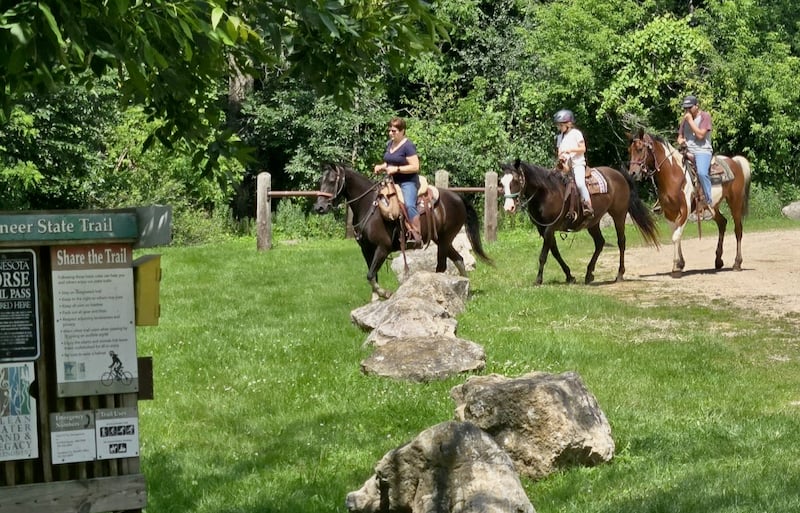
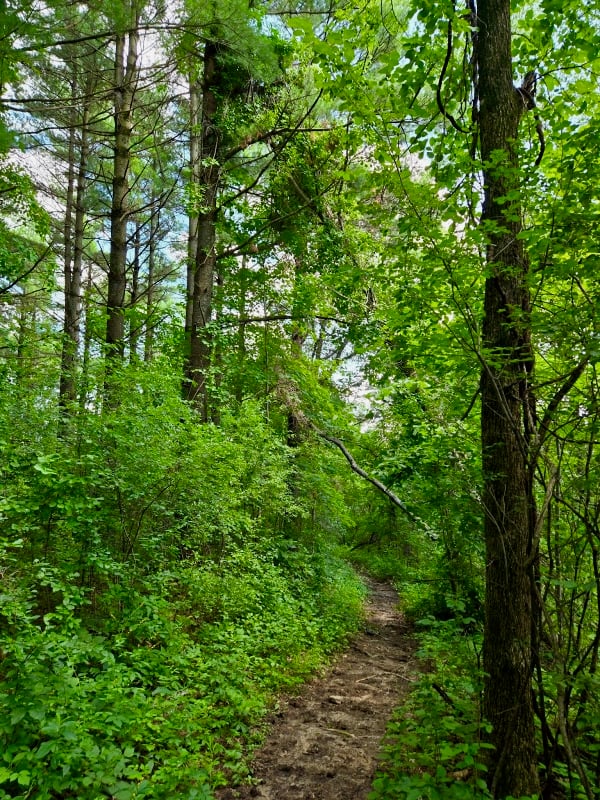
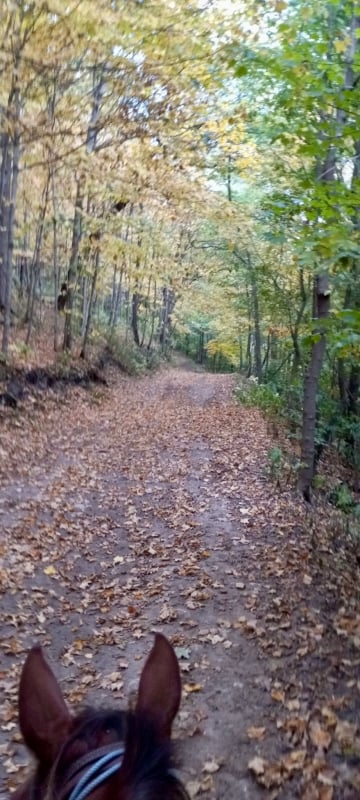
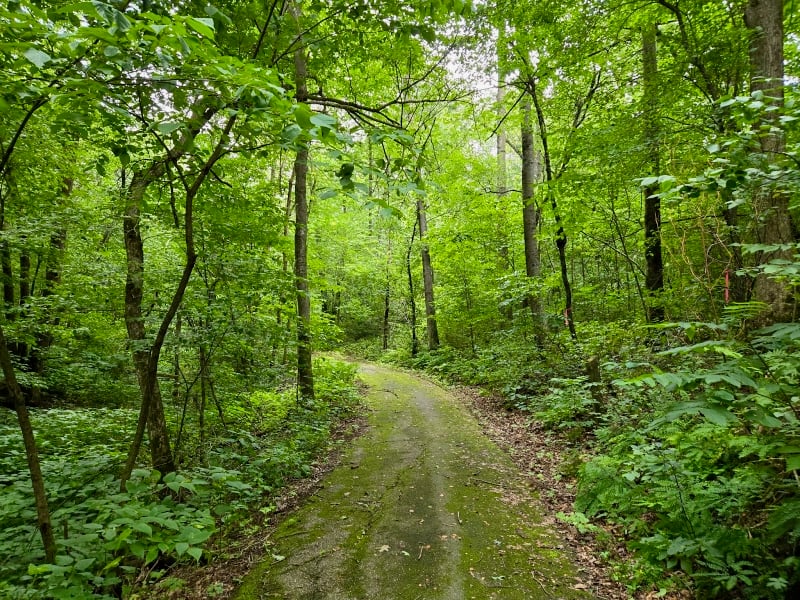
Twin destinations: Kruger and Zumbro Bottoms
Frontenac State Park manages four campgrounds in these twin units—the Kruger Campground and Day Use Unit, next to the Zumbro River south of Wabasha (this one’s just for humans), and to the southwest, the West, North and Central campgrounds in the Zumbro Bottoms Management Unit, designed for horse trail riders and their steeds as well as nonequestrian visitors.
The 19-site Kruger campground, which is classified as primitive (meaning, vault toilets and no fancy shower buildings—hey! Who needs a shower when you can swim in the Zumbro?), is close to a lovely picnic area, canoe access to the Zumbro, and three trails. The paved Easy Wheeling Trail is pretty, short and wheelchair-accessible. A nearby two-mile trail for hikers and skiers winds up into higher terrain. A third trail, about 5 miles long and more challenging, is open to hikers, skiers and horseback riders. Like Hay Creek’s trails, the latter two trails are rugged, climbing into high, beautiful terrain. (When your newsletter editor visited in mid-July, parts of these trails were closed because of downed trees and washouts by heavy rains. Hopefully that’ll all be cleaned up by August, but take heed of any trail signage when you visit.)
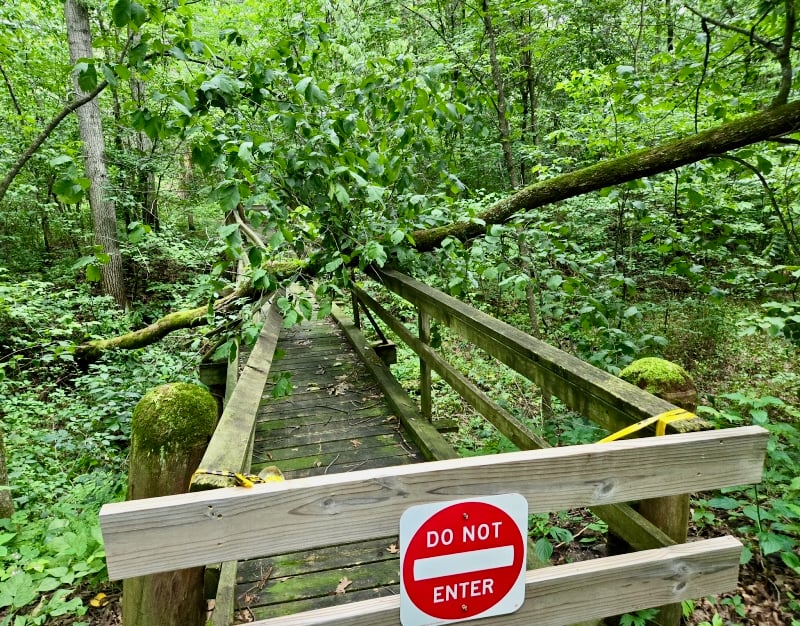
A word about Minnesota state forests: State forests differ in significant ways from state parks. They’re managed to allow for a broad range of recreational activity, including hunting and fishing, as well as for some timber harvesting and trail vehicle access. In state parks, foraging is restricted to edible fruiting bodies such as berries, nuts and mushrooms, while state forests allow for a broader collection of plant material such as ramps (wild leeks). State forests and wildlife management areas represent a history of respect for local residents who value both preservation and practical usage. We encourage you to visit these areas in between your trips to our beloved, growing Frontenac State Park!
Last but not least, who was Richard J. Dorer? The passionate Minnesota conservationist (1889-1973) for whom these units and a vast forestland beyond are named was a man far ahead of his time. He was a World War I veteran who went on to fight for wetlands and forests. Your newsletter editor has had the privilege to visit his grave in lovely, quiet Beaver Cemetery high on a hill in the Whitewater Wildlife Management Area. If you’re interested in history, read up on Dorer, the Whitewater area, and state forests in general.
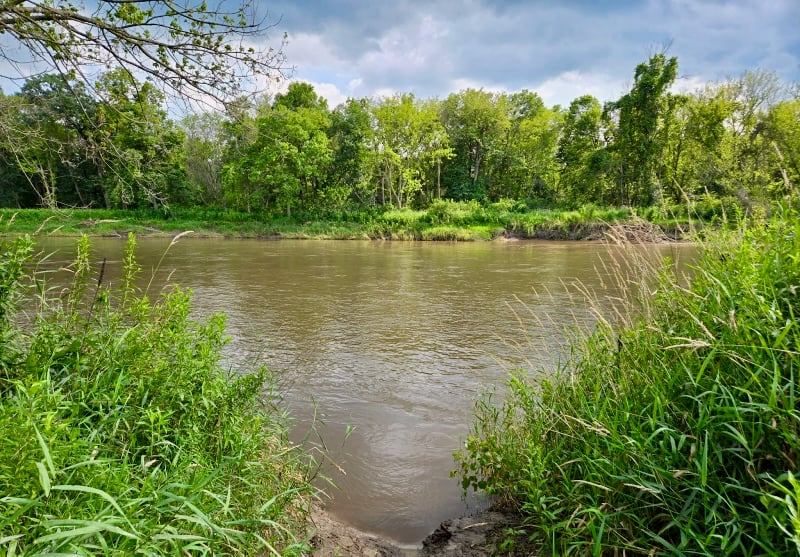

Speaking of the Zumbro River Valley, we’d like to give a shout-out to another terrific newsletter set in the wilds of our region, the one put out by our dear friends at Zumbro Valley Audubon. Like our own newsletter, it’s distributed monthly by email, free and with no annoying spam. You can find the latest issue, full of great photos and information about butterflies, birds, animals and local conservation efforts, here.
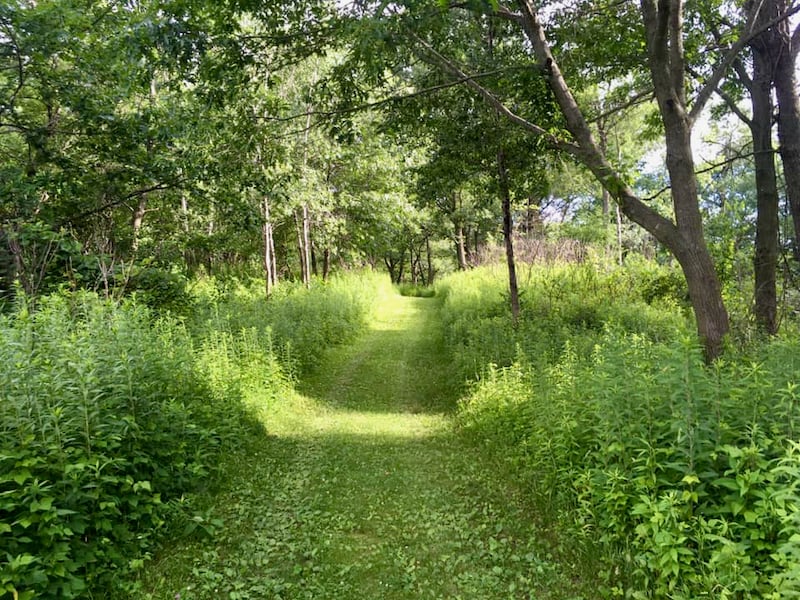
Updates from our park manager
Jake Gaster, our park’s manager, offered these midsummer updates:
We added self-guided prairie plant ID signs to the short prairie loop behind park headquarters. Thanks to the Eagle Scouts who over the course of two projects created and then enhanced this display.
Bummer dam news: The beaver dam that had been keeping Pleasant Valley Lakelet at a healthy level washed out, dropping the water level in the pond by around 2 feet. It remains to be seen how the beavers will react or if anything else can be done about this.
We have … mosquitoes. [Thanks, Jake. WE HAD NOT NOTICED!] Our normally largely mosquito-free park (if you exclude Sand Point) is abuzz with the happy little bloodsuckers. “I am more than a little bit excited for things to dry out and for them to go away,” said Jake. Us too!
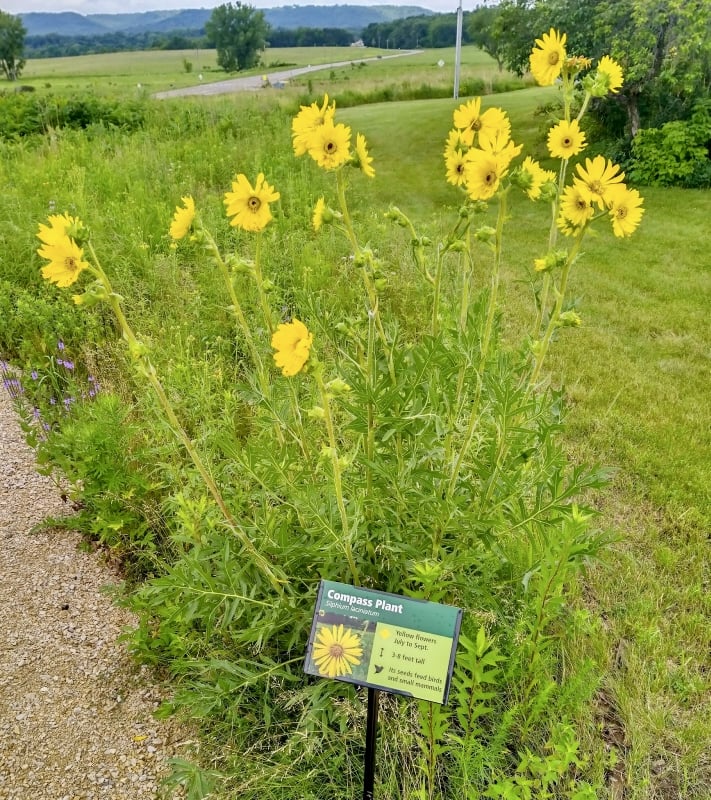
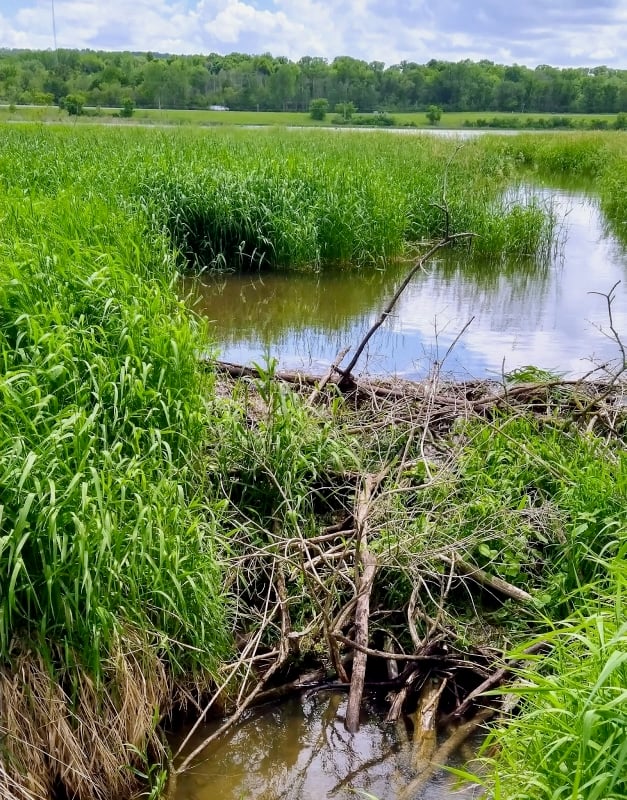
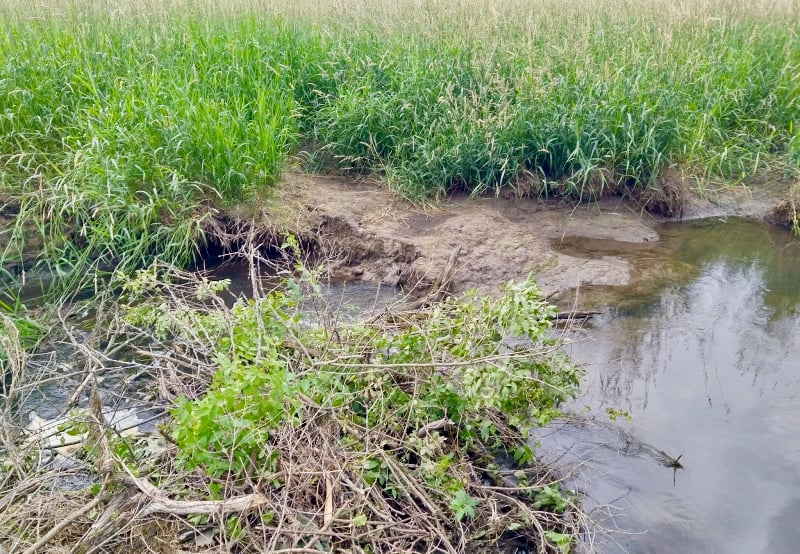
What we did in July, and what we’re up to in August
Your FSPA friends kept busy in July, leading lots of nature walks and teaching preschoolers about insects at our July Nature Explorers event. The kids AND the insects cooperated! Photos:
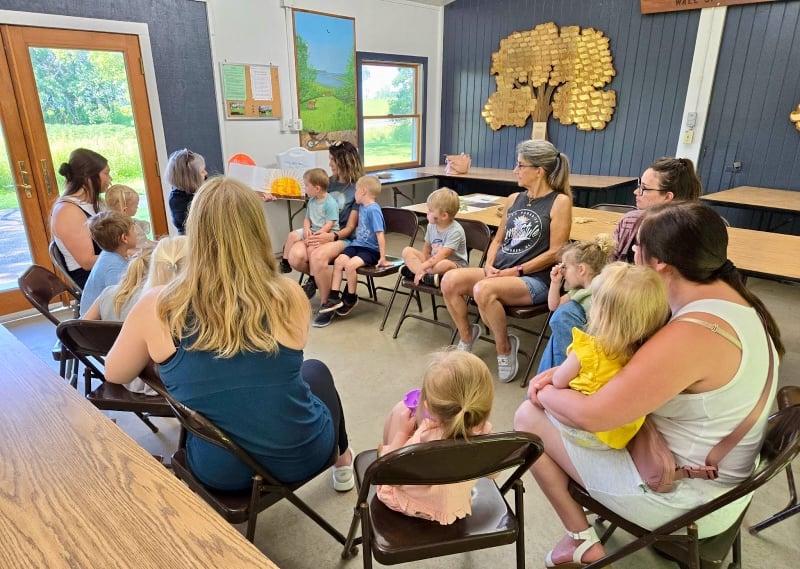
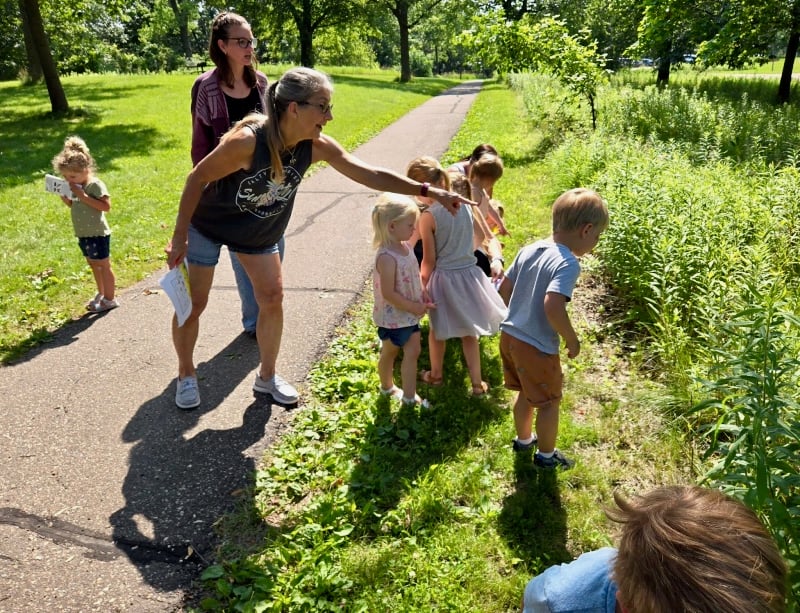
August events in the park
Saturday, Aug. 3, 9-11 a.m.: Ranger Jake Gaster leads a talk-and-walk on postfire ecology and native plants, leaving from campground kiosk.
Saturday, Aug. 3, 1-3 p.m.; Archery in the Park. Meet in the campground play area by the third and fourth loops. This archery program provides hands-on instruction on shooting a bow and arrow from certified instructors in a safe and supportive environment. Family- and kid-friendly equipment designed for beginners ages 8 and older. Children age 15 and under must be accompanied by an adult. All equipment is provided. Personal archery equipment is not allowed. Participants will be outside for the program. Bring sunscreen, sunglasses, hat, insect repellent and water. Program will be canceled if it rains. All archery programs are free with a Minnesota State Parks vehicle entrance permit.
Saturday, Aug. 3, 10-11 a.m.: Nature walk with interpretive naturalist Bruce Ause, leaving from campground kiosk.
Saturday, Aug. 10, 9-11 a.m.: Guided bird walk with FSPA members Janet Malotky and Steve Dietz, leaving from campground kiosk.
Saturday, Aug. 10, 10-11 a.m.: Nature walk with interpretive naturalist Bruce Ause, leaving from campground kiosk.
Saturday, Aug.10, 11:30 a.m.-12:30 p.m.: Explore Frontenac State Park with the Minnesota DNR’s Christina Locke, pollinator conservation coordinator, and Mike Dunker, regional naturalist. Participants will learn about vital insect pollinators, their host plants and how these species play a role in building and maintaining healthy watersheds. In collaboration with Lake Pepin Legacy Alliance. Meet at the ranger station at the park entrance. This walk is beginner-friendly. Please wear tick-safe apparel and appropriate shoes and sun protection for walking in open tall-grass prairie.
Tuesday, Aug. 13, 10-11 a.m.: Nature Explorers: Wildlife, for preschoolers, with interpretive naturalist Sara Holger and FSPA volunteers, main picnic shelter. Here’s our handy-dandy flier, for printing out and putting on your refrigerator:
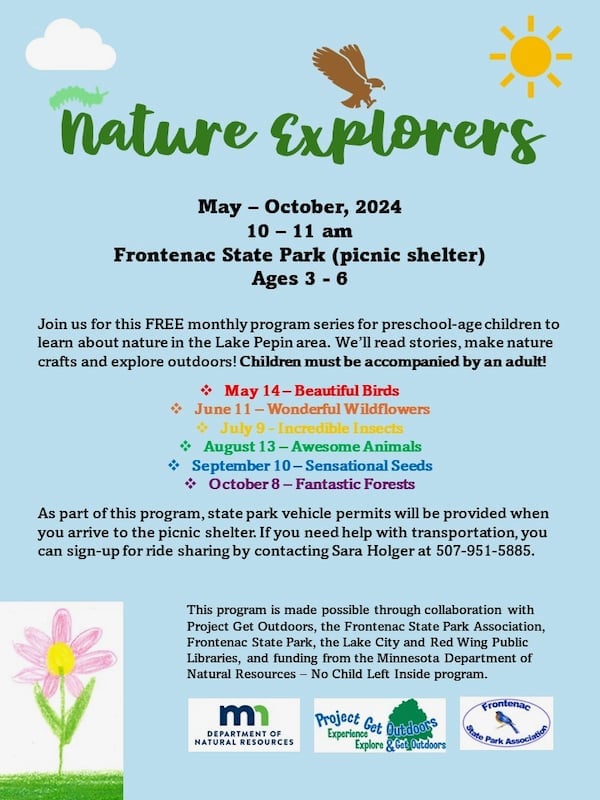
Thursday, Aug. 15, 3-4:30 p.m.: FSPA’s quarterly meeting, main picnic shelter. Lots of review and planning discussions, as well as some nature yarns and groan-worthy jokes, at these membership meetings. Interested in joining, or just learning who we are, what we do, and what we dream of doing? All are welcome. And, say! We’ll have treats!
Saturday, Aug. 17, 10-11 a.m.: Nature walk with interpretive naturalist Bruce Ause, leaving from campground kiosk.
Saturday, Aug. 24, 10-11 a.m.: Nature walk with interpretive naturalist Bruce Ause, leaving from campground kiosk.
Saturday, Aug. 31, 10-11 a.m.: Nature walk with interpretive naturalist Bruce Ause, leaving from campground kiosk.
Saturday, Aug. 31, 1-3 p.m.: Archery in the Park. Meet in the campground play area by the third and fourth loops. This archery program provides hands-on instruction on shooting a bow and arrow from certified instructors in a safe and supportive environment. Family- and kid-friendly equipment designed for beginners ages 8 and older. Children age 15 and under must be accompanied by an adult. All equipment is provided. Personal archery equipment is not allowed. Participants will be outside for the program. Bring sunscreen, sunglasses, hat, insect repellent and water. Program will be canceled if it rains. All archery programs are free with a Minnesota State Parks vehicle entrance permit.
Saturday, Aug. 31, 7 p.m.: Starry, Starry Night program with the Rochester Astronomy Club, beginning with a 45-minute presentation at the picnic shelter before star viewing from the main parking lot. (Note: The July 6 sky viewing program was well-attended even though the night sky was a bit cloudy. We were delighted to see lots of kids at that one, and even more to hear the great questions they asked our astronomer friends.)
Sunday, Sept. 1: The peregrine falcon has long fascinated us for its dramatic migration and amazing downward-spiraling hunting flight. Sixty years ago, there were none in the Upper Midwest. Today nearly 350 nesting pairs of falcons make their home here. Jackie Fallon, with the Midwest Peregrine Society, will present this program along with several falcons to help us understand their past, present and future in Frontenac State Park and the Upper Midwest. This free event will take place right next to the ranger station; you do need to have a state park pass, either daily or annual, if you drive into the park for it.
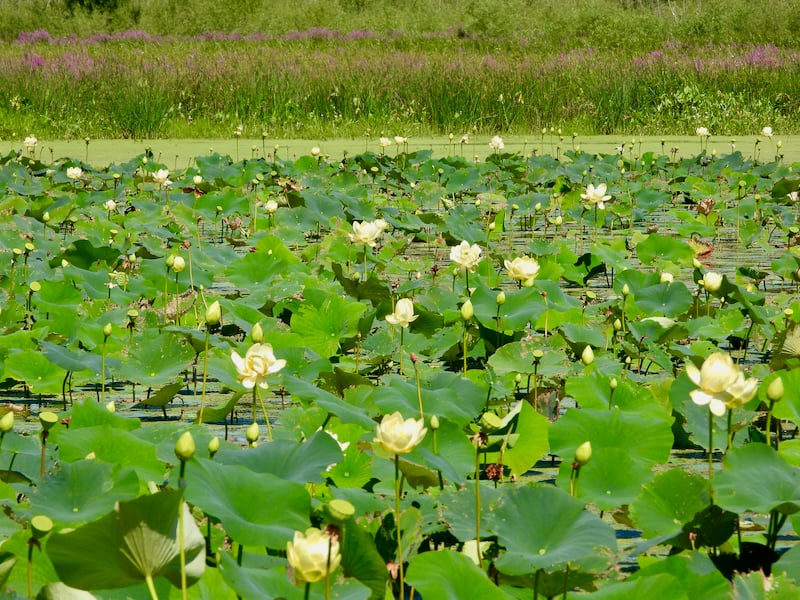
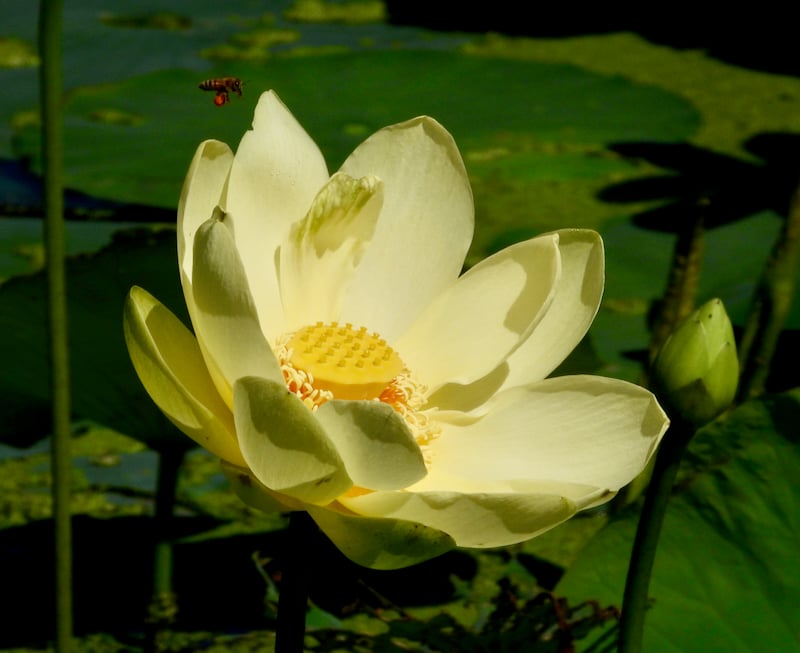
Bird note: Merlin said …
By Janet Malotky, Minnesota Master Naturalist volunteer
For a few weeks this spring when I was walking the Prairie Trail, the (fantastic and free) Merlin Bird ID app kept sound-IDing a Northern Mockingbird. But contrary to what its name would suggest, this bird is considered rare in Minnesota. Go south a few states and you will find them all over, but not here. So why the repeated identifications? Merlin is supposed to help me out, not lead me astray, right?
Thus the standard caution from experienced birders everywhere: a Merlin sound ID should never be relied upon as the sole source of identification for any bird. You need to see the bird yourself and/or recognize the song from experience.
Merlin is a fantastic window into the natural world, a wonderful aid to bird ID, and it’s fun, but it has a tough job. Sounds in the environment are rarely isolated. All kinds of birds are often singing at once, along with the distant train whistle, cricket, frog, squirrel, lawn mower, sneeze, laugh, and woof.
Plus, birds don’t read the field guides about how they are supposed to sing. Sometimes the song is just a snippet. Sometimes it’s a bit scrambled. Sometimes it sounds like an entirely different bird. All these factors are especially true at this time of year, when new fledglings are trying out their pipes for the first time.
We had an Indigo Bunting (lovely but common) behind our house that sounded exactly like a Prothonotary Warbler (lovely and unlikely). It was even ID’d as such by Merlin. Normally, their songs are not alike. We took to calling it our resident Prothonotary Bunting. But over time, it has gradually tuned its song to sound like a typical Indigo Bunting.
One morning on the prairie when Merlin indicated yet again that a Northern Mockingbird was nearby, I decided to hunt down the bird. I suspected a favorite: the delightful Brown Thrasher, a rusty-colored robin-sized bird with a long tail and long downward-curving bill. Both birds are repeaters, in two senses of that word. First, they are both excellent mimics of other sounds, birds and otherwise. Second, they both tend to repeat snippets of sound within their songs. There’s a key, identifying difference though. The Northern Mockingbird generally repeats each snippet three or more times, while the Brown Thrasher repeats each twice.

Don’t hold me (or them) to this, though! Remember, birds don’t study field guides. But there are enough similarities in their songs to suggest a likely Merlin misidentification.
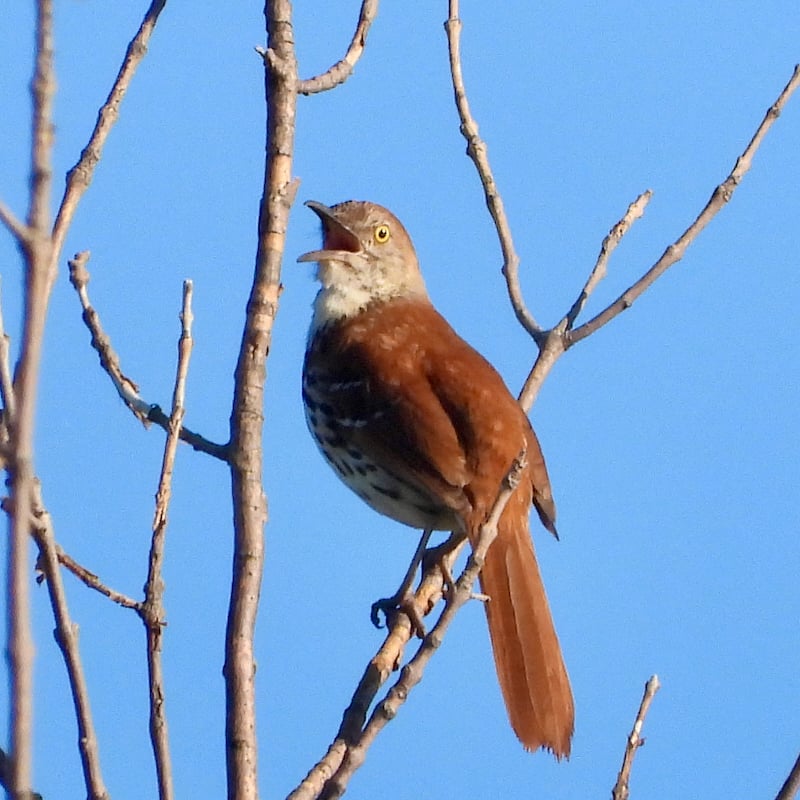
After some wandering and scanning, I was able to find the singer that day. And it was a lovely Brown Thrasher, singing its heart out from the top branch of a tall tree. Thank you for your song, little bird!
Mushroom of the month: All hail, king bolete
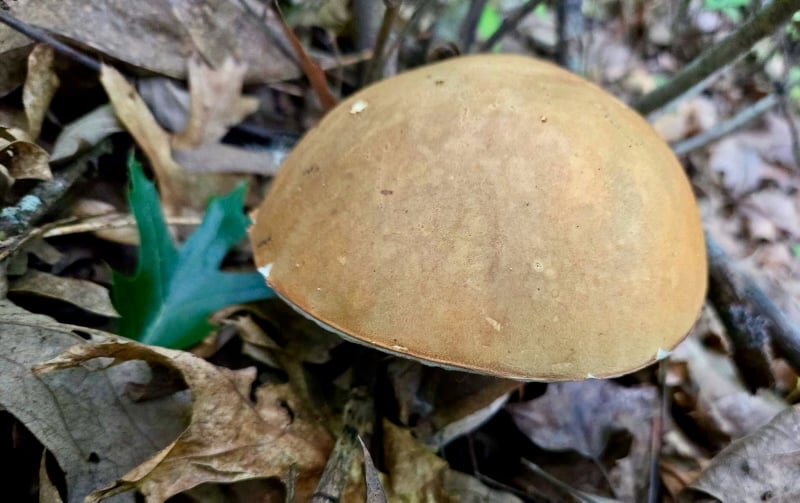
By Pamela Miller, Minnesota Master Naturalist volunteer
Your rather fungi-obsessed newsletter editor jumped in joy—and surprise—when she spotted a bunch of these hamburger-bun-shaped mushrooms in the park recently while scouting for chanterelles (which are out in abundance this rainy summer). It’s a king bolete (Boletus edulis). When you see charming art renderings of rosy-cheeked European peasants carrying basketfuls of edible mushrooms, the mushroom they’re toting usually is the king bolete, although they’d be more likely to call it a porcini, cep, steinpilz or penny bun. A universal treasure!
The king bolete is such a hot item that it graces the cover of the wonderful guidebook “Mushrooms of the Upper Midwest” by Kathy Yerich and Teresa Marrone. (We highly recommend that book, which is available in the little store at park headquarters.)
In Minnesota, king boletes are usually found up north, where the conifers they favor grow in abundance, but they also can be found under hardwoods, especially oaks. Finding them is tricky—once they fruit, there’s only a two- to three-day window before they fade. Many foragers consider king boletes the best edible mushroom, claiming that its umami flavor is so strong that you don’t even need to enhance it with white wine, butter, garlic and the other accouterments we usually advise dousing edible mushrooms with.
A word of caution, though—many boletes (all of which have pores, not gills, underneath their caps) grow in our area, and many are toxic. Fresh kings have a distinctive reticulation on their stems and do not bruise or change color when handled. Look for them this month if rain is followed by relatively cool weather.
The frog that paid a house visit
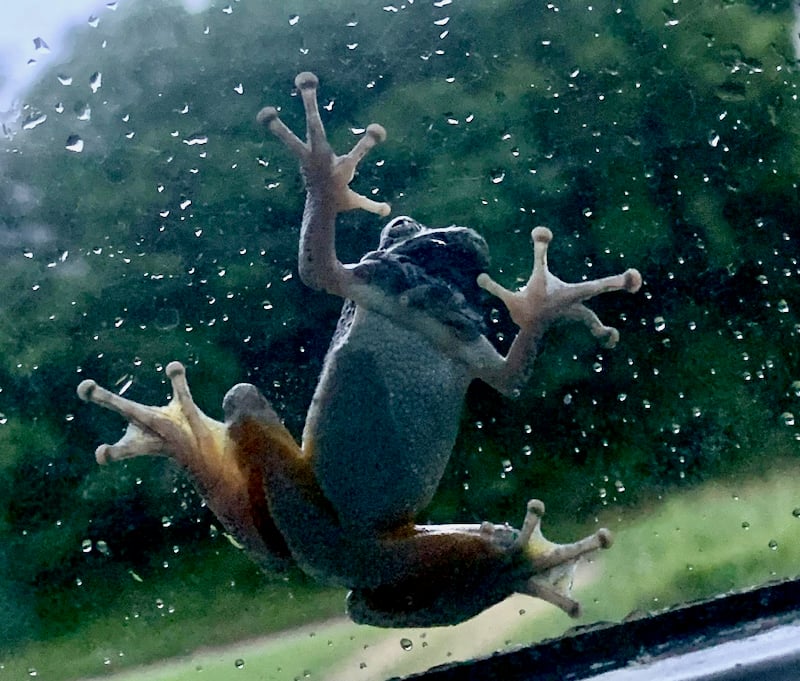
Last month’s newsletter included this photo of a sticky-toed little creature that FSPA member Wally Siewert spotted on his window and photographed. What is it?, we asked you. Several of you wags promptly got back to us to inform us it was … a frog.
Thanks, knuckleheads. You’re right! More specifically, it’s either a common gray treefrog or a Cope’s gray treefrog—the two can only be distinguished accurately by their calls. Our frog-loving friends at the Minnesota Department of Natural Resources tell us that the gray treefrog can change colors, going from white to gray to green, but the inner thighs of its hind legs are always yellow. When perched in trees, they sing, emitting a birdlike trill.
What brought it to Wally’s window? According to the DNR, they like windows because the bugs they eat are attracted to indoor lights.
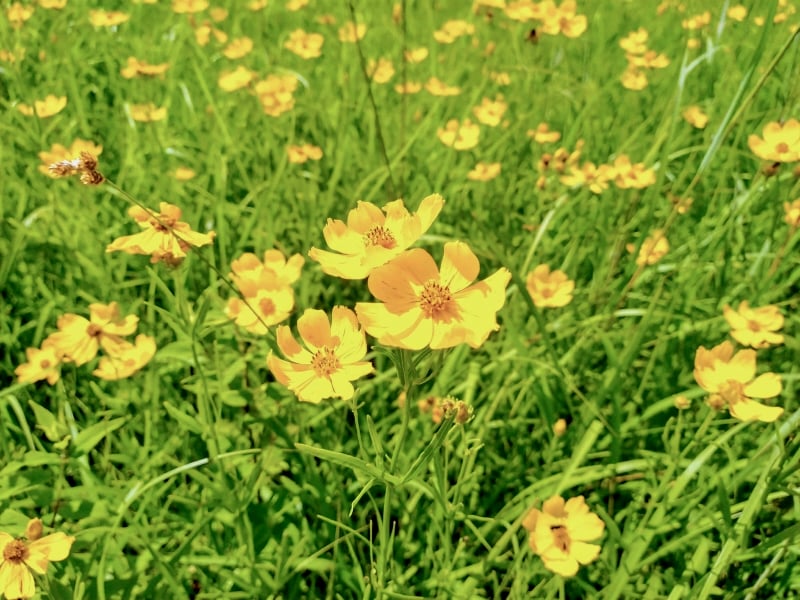
Notes from the Field: Unionid hitchhikers
By Steve Dietz, Minnesota Master Naturalist volunteer
FSPA members recently had the opportunity to visit the MN DNR’s Lake City mussel lab, more formally known as the Center for Aquatic Mollusk Programs (CAMP).
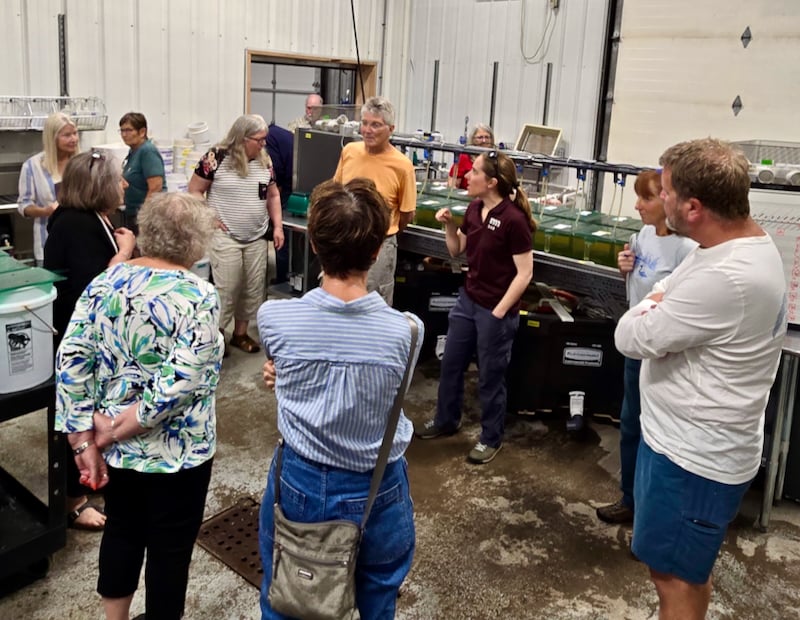
Interestingly, despite the fact that freshwater mussels or unionids are members of the second largest group of animals in the world, and are often the dominant members of animal communities found in the substrates of streams and lakes, until around 2010, they were relatively unstudied and hence not well understood. The Lake City facility is the only one in the state and one of relatively few in the country.
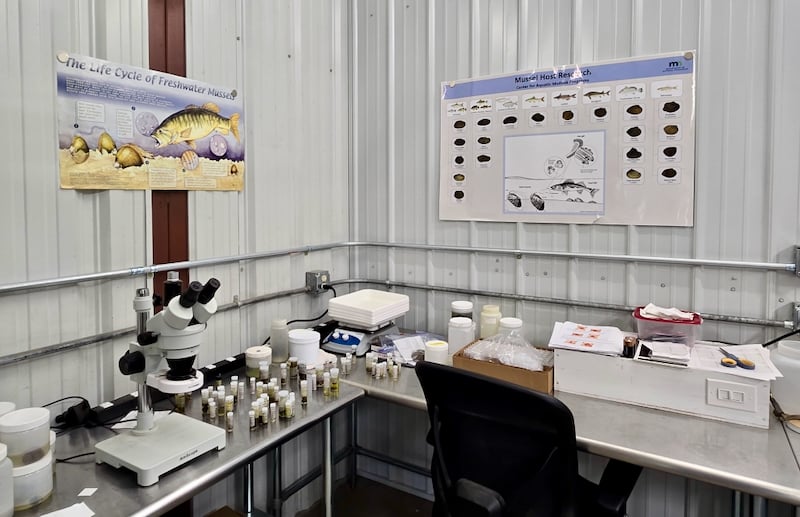
We learned many fascinating facts about freshwater mussels, chief among them that they perform important “ecosystem services” like filtering water and pulling out inaccessible nutrients that other animals rely on.
Perhaps most interesting, however, is how mussels reproduce, relying on fish, sometimes specific species, to become essentially surrogate parents for a period of time. Mussels do have a “foot,” which they can use to move around, but slowly, very slowly, so how do they “capture” their larva or glochidia’s hosts?
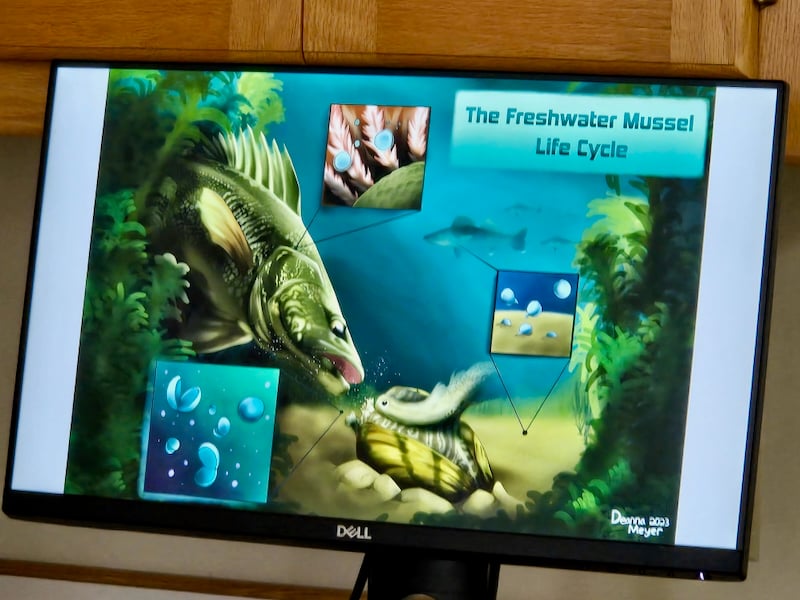
Many mussel species have specialized adaptations, which can involve elaborate examples of food mimicry to elicit an attack by a potential host. For example, Kate told us about the pocketbook mussel, which has special flaps on its mantle that resemble a small fish. The mussel extends the flaps and waves its “lure”. It is so realistic, largemouth bass try to strike, thinking it is a tasty minnow. Instead, it gets a mouthful of glochidia, which clamp on its gills and hitch a ride for a few weeks!
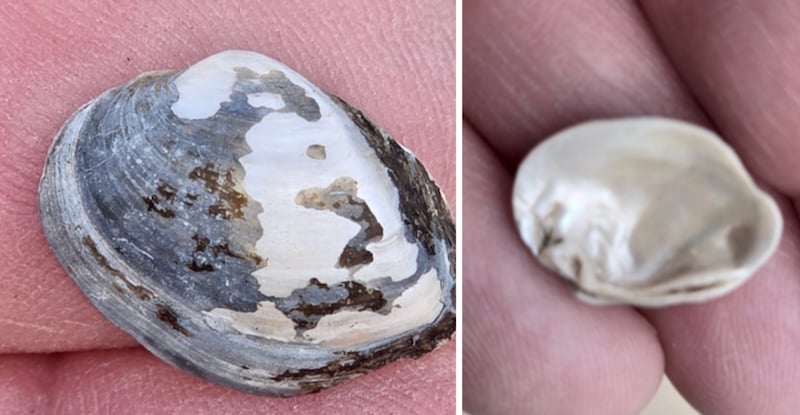
Poem(s) of the month
“AUGUST NIGHT”
By Elizabeth Madox Roberts (American; 1881-1941)
We had to wait for the heat to pass,
And I was lying on the grass,
While Mother sat outside the door,
And I saw how many stars there were.
Beyond the tree, beyond the air,
And more and more were always there.
So many that I think they must
Be sprinkled on the sky like dust.
Dust is coming through the sky!
And I felt myself begin to cry.
So many of them and so small,
Suppose I cannot know them all.
Our second poem is by FSPA member and newsletter bird columnist Janet Malotky. We recently discovered that she’s an accomplished poet!
How about you, readers? Do you write poetry about nature, perhaps inspired by Frontenac State Park? If so, feel free to submit those poems to us at pamelamarianmiller@gmail.com—we’ll occasionally publish some of the best ones.
“HIGH WATER”
By Janet Malotky (Old Frontenac resident and FSPA newsletter bird columnist)
After three years of drought
the rain came
each day a baptism
into leaf and soil
each gray hour an augury
of rootlet, egg, and spore
Sheets of rain washed down
and the river rose
lapped into the low places
sponged by the soil
of floodplain trees
it doused their fungal networks
with joy
Rain came
and the water rose
Downed trees
drifted like icebergs in the river
their underwater mass
mysterious and fearsome
Wind drove their trunks
into the forest
to rock and murmur
against the living trees
Ducks and beavers dazzled
at their prospects
We went to the river
to gauge its lapping edge
to inhale the liquid gradient
between sky, river
and bloodstream
To understand its flow
as a function of moon and longing
and to drink
through the soles of our feet
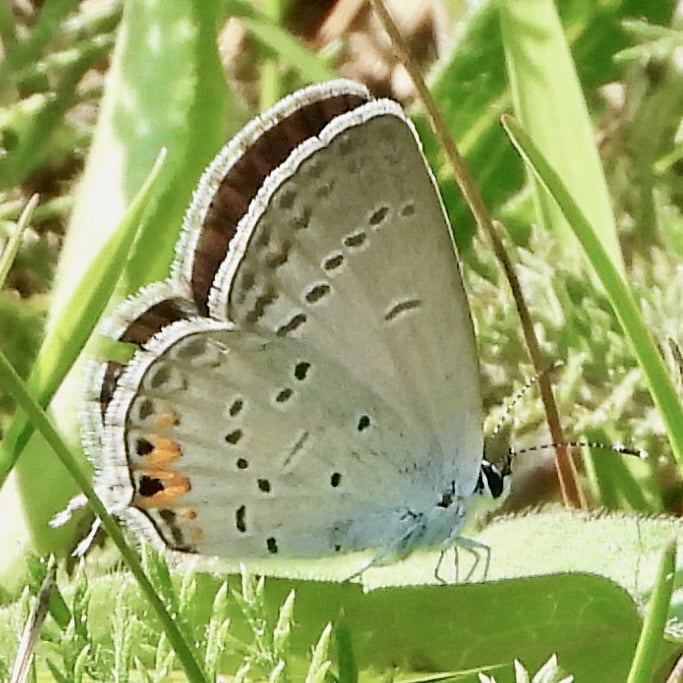
Interested in joining the FSPA?
We’d be honored to have your support. Dues are $25 per year for an individual, $35 for dual/family membership. Here’s a link with signup information.
A reminder that joining us occasionally to help with volunteer efforts is awesome too, even if you’re not a member. The FSPA’s goal is simply to share our love of Frontenac State Park with as many people as possible.
To sign up to regularly receive this free and gloriously spam-free monthly newsletter, click on “Subscribe” below. Feel free to send questions or comments to your newsletter editor at pamelamarianmiller@gmail.com. Questions about the FSPA? You can reach hard-working FSPA chair Steve Dietz at stevedietz@duck.com.
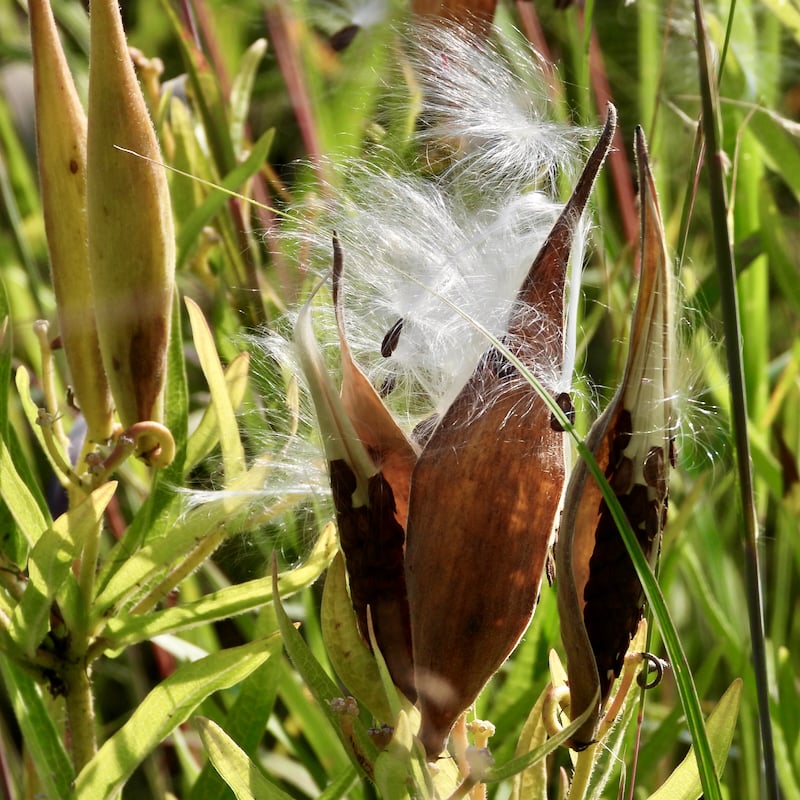
Handy links for more information and education
Frontenac State Park website
Frontenac State Park Association website
If you take pictures in the park, tag us on Instagram
Frontenac State Park bird checklist
Frontenac State Park on iNaturalist
Website for our township, Florence Township
Minnesota Master Naturalist program
Red Wing Environmental Learning Center
Lake City Environmental Learning Program on FB
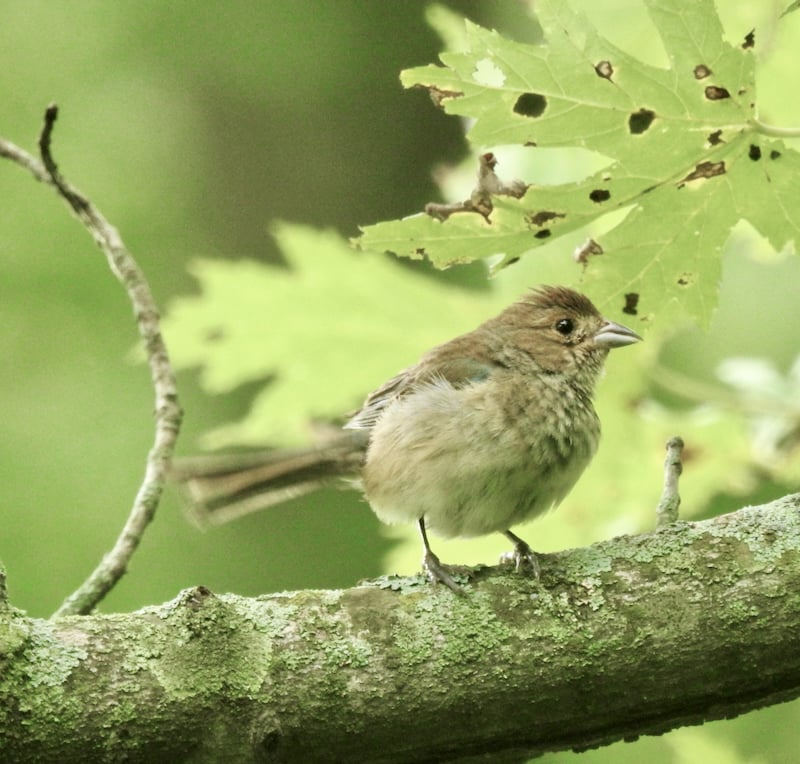
Frontenac State Park staff
Jake Gaster, park manager; Amy Jay, assistant park manager; Amy Poss, lead field worker
Parting shots
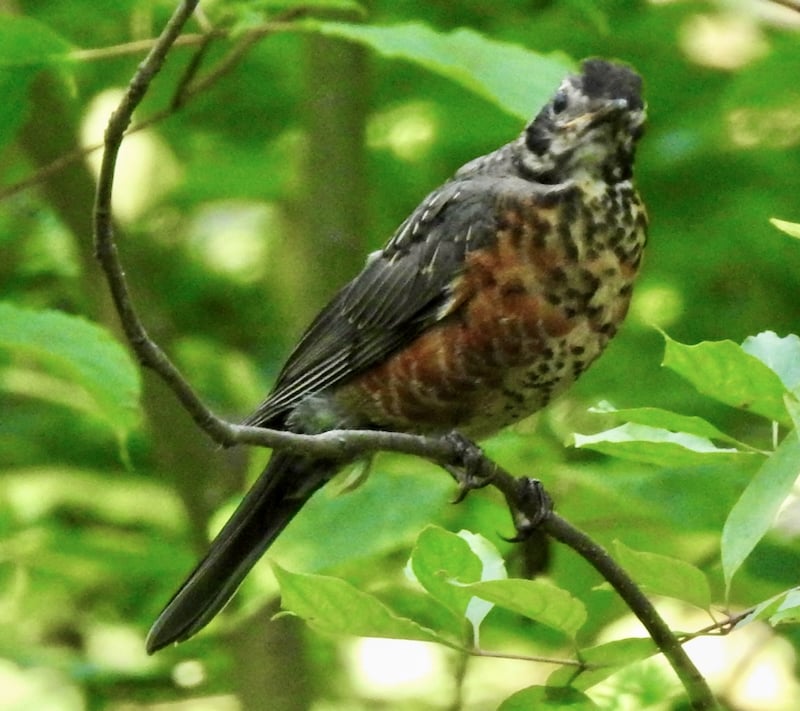
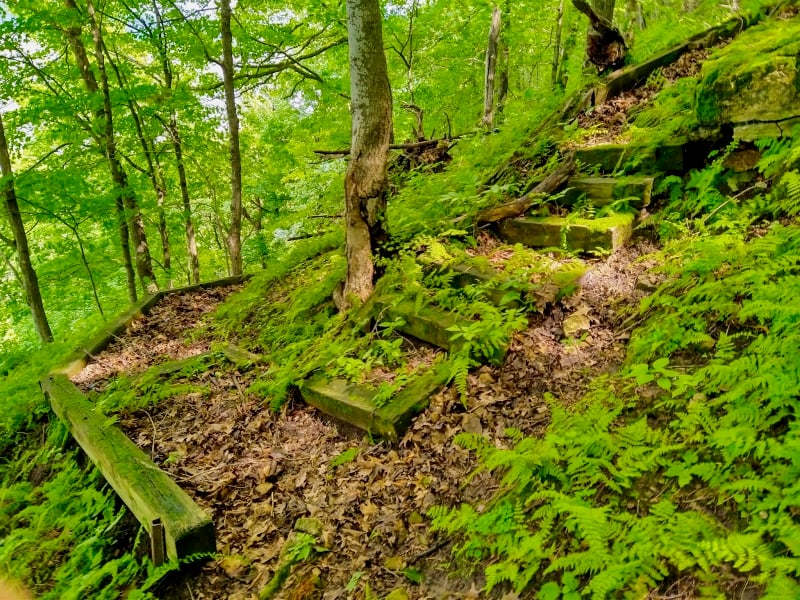
Thank you, readers and park visitors!
This is Volume 2, No. 8 of the Frontenac State Park Association newsletter, which was launched in April 2023.
Here’s where to browse the full archives of this newsletter.
